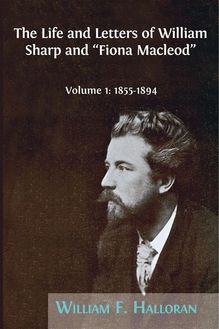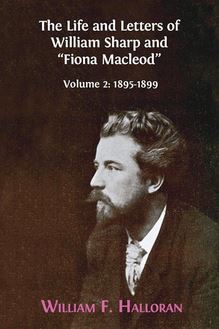The Life and Letters of William Sharp and "Fiona Macleod". Volume 2: 1895-1899 , livre ebook
316
pages
English
Ebooks
2020
Vous pourrez modifier la taille du texte de cet ouvrage
Obtenez un accès à la bibliothèque pour le consulter en ligne En savoir plus
Découvre YouScribe en t'inscrivant gratuitement
Découvre YouScribe en t'inscrivant gratuitement
316
pages
English
Ebooks
2020
Vous pourrez modifier la taille du texte de cet ouvrage
Obtenez un accès à la bibliothèque pour le consulter en ligne En savoir plus
Publié par
Date de parution
14 avril 2020
Nombre de lectures
1
EAN13
9781783748723
Langue
English
Poids de l'ouvrage
5 Mo
—Andrew Hook, Emeritus Bradley Professor of English and American Literature, Glasgow University
William Sharp (1855-1905) conducted one of the most audacious literary deceptions of his or any time. Sharp was a Scottish poet, novelist, biographer and editor who in 1893 began to write critically and commercially successful books under the name Fiona Macleod. This was far more than just a pseudonym: he corresponded as Macleod, enlisting his sister to provide the handwriting and address, and for more than a decade "Fiona Macleod" duped not only the general public but such literary luminaries as William Butler Yeats and, in America, E. C. Stedman.
Sharp wrote "I feel another self within me now more than ever; it is as if I were possessed by a spirit who must speak out". This three-volume collection brings together Sharp’s own correspondence – a fascinating trove in its own right, by a Victorian man of letters who was on intimate terms with writers including Dante Gabriel Rossetti, Walter Pater, and George Meredith – and the Fiona Macleod letters, which bring to life Sharp’s intriguing "second self".
With an introduction and detailed notes by William F. Halloran, this richly rewarding collection offers a wonderful insight into the literary landscape of the time, while also investigating a strange and underappreciated phenomenon of late-nineteenth-century English literature. It is essential for scholars of the period, and it is an illuminating read for anyone interested in authorship and identity.
Publié par
Date de parution
14 avril 2020
Nombre de lectures
1
EAN13
9781783748723
Langue
English
Poids de l'ouvrage
5 Mo
THE LIFE AND LETTERS OF WILLIAM SHARP AND “FIONA MACLEOD” VOL. II
The Life and Letters of Will iam Sharp and “Fiona Macleod”
VOLUME II: 1895–1899
William F. Halloran
https://www.openbookpublishers.com
©2020 William F. Halloran
This work is licensed under a Creative Commons Attribution 4.0 International license (CC BY 4.0). This license allows you to share, copy, distribute and transmit the text; to adapt the text and to make commercial use of the text providing attribution is made to the authors (but not in any way that suggests that they endorse you or your use of the work).
Attribution should include the following information: William F. Halloran, The Life and Letters of William Sharp and “Fiona Macleod”. Volume 2: 1855–1894 . Cambridge, UK: Open Book Publishers, 2020. https://doi.org/10.11647/OBP.0196
In order to access detailed and updated information on the license, please visit https://doi.org/10.11647/OBP.0196#copyright
Further details about CC BY licenses are available at https://creativecommons.org/licenses/by/4.0/
All external links were active upon publication unless otherwise stated and have been archived via the Internet Archive Wayback Machine at https://archive.org/web
Updated digital material and resources associated with this volume are available at https://doi.org/10.11647/OBP.0196#resources
Every effort has been made to identify and contact copyright holders and any omission or error will be corrected if notification is made to the publisher.
ISBN Paperback: 978-1-78374-869-3
ISBN Hardback: 978-1-78374-870-9
ISBN Digital (PDF): 978-1-78374-871-6
ISBN Digital ebook (epub): 978-1-78374-872-3
ISBN Digital ebook (mobi): 978-1-78374-873-0
ISBN Digital (XML): 978-1-78374-874-7
DOI: 10.11647/OBP.0196
Cover image: “Mr William Sharp: from a photograph by Frederick Hollyer: The Chap-book , September 15, 1894”, Wikimedia, Public Domain, https://commons.wikimedia.org/wiki/File:William_Sharp_1894.jpg#/media/File:William_Sharp_1894.jpg
Cover design: Anna Gatti.
To the memory of
Noel and Rosemarie Sharp
and
Esther Mona Harvey
Contents
Acknowledgements
ix
Introduction
1
Chapter Twelve: January–June, 1895
11
Chapter Thirteen: July–December, 1895
71
Chapter Fourteen: January–June, 1896
141
Chapter Fifteen: July–December, 1896
215
Chapter Sixteen: 1897
283
Chapter Seventeen: 1898
357
Chapter Eighteen: January–June, 1899
417
Chapter Nineteen: July–December, 1899
483
Endnotes
527
List of Illustrations
613
Appendix
617
Acknowledgements
William Sharp’s wife and first cousin, Elizabeth Amelia Sharp, became his literary executor when he died in 1905. Upon her death in 1932, the executorship passed to her brother, Robert Farquharson Sharp. When he passed away in 1945, that role fell to his son, Noel Farquharson Sharp, who, like his father, was a keeper of printed books in the British Museum. When he died in 1978, the executorship fell to his wife, Rosemarie Sharp, who lived until 2011 when it passed to her son, Robin Sharp.
I am heavily indebted to Noel and Rosemarie Sharp for their assistance and friendship. They granted me permission to publish William Sharp’s writings and shared their memories of his relatives and friends. I am especially grateful to Noel Sharp for introducing me in 1963 to Edith Wingate Rinder’s daughter, Esther Mona Harvey, a remarkably talented woman whose friendship lasted until her death in 1993. Her recollections of her mother, who played a crucial role in the lives of William and Elizabeth Sharp, were invaluable.
Through many years of my involvement with an obscure and complex man named William Sharp, my wife — Mary Helen Griffin Halloran — has been endlessly patient, encouraging and supportive. This work has benefited greatly from her editorial skills.
I am also grateful to a succession of English graduate students at the University of Wisconsin–Milwaukee who assisted me in transcribing and annotating William Sharp’s letters: Edward Bednar, Ann Anderson Allen, Richard Nanian, and Trevor Russell. Without the support I received from the College of Letters and Science and the Graduate School of the University of Wisconsin–Milwaukee this project would not have seen the light of day.
The Appendix lists the institutions that have made copies of their Sharp/Macleod letters available and granted permission to transcribe, edit, and include them in this volume. It also lists the letters held by each institution. Without these libraries, their benefactors, and their competent staffs, a project of this sort — which has stretched over half a century — would have been impossible.
Finally, this project would not have come to fruition had it not been for Warwick Gould, Emeritus Professor and Founding Director of the Institute for English Studies at the University of London. It was he who supported the first iteration of the Sharp letters as a website supported by the Institute, and it was he who suggested Open Book Publishers as a possible location for an expanded edition of The Life and Letters of William Sharp and Fiona Macleod . His support and friendship have been a beacon of light.
This is the second volume of a three-volume work which presents Sharp’s life from 1895 through 1899. The first volume rages from 1855, the year of his birth, through 1894; and the third from 1900 through 1905, the year of his death.
Introduction 1
© William F. Halloran, CC BY 4.0 https://doi.org/10.11647/OBP.0196.09
William Sharp was born in Paisley, near Glasgow, in 1855. His father, a successful merchant, moved his family to Glasgow in 1867; his mother, Katherine Brooks, was the daughter of the Swedish Vice Consul in Glasgow. A talented, adventurous boy who read voraciously, he spent summers with his family in the Inner Hebrides where he developed a strong attachment to the land and the people. In the summer of 1863, his paternal aunt brought her children from London to vacation with their cousins. Months short of his eighth birthday, Sharp formed a bond with one of those cousins, Elizabeth Sharp, a bright girl who shared many of his enthusiasms. Their meeting led eventually to their engagement (in 1875) and their marriage (in 1884).
After finishing school at the Glasgow Academy in 1871, Sharp studied literature for two years at Glasgow University, an experience that fed his desire to become a writer. Following his father’s sudden death in August 1876, he fell ill and sailed to Australia to recover his health and look for suitable work. Finding none, he enjoyed a warm and adventurous summer and returned in June 1877 to London where he spent several weeks with Elizabeth and her friends. A year later he settled in London and began to establish himself as a poet, journalist, and editor. Through Elizabeth’s contacts and those he made among writers, including Dante Gabriel Rossetti, he became by the end of the 1880s a well-established figure in the literary and intellectual life of the city. During this decade he published biographical studies of Rossetti, Percy Bysshe Shelley, and Robert Browning; three books of poetry; two novels; many articles and reviews; and several editions of other writers. None of those publications brought the recognition he sought. By 1890 he had accumulated enough money to reduce his editing and reviewing and devote more time to poetry and prose.
That autumn he and Elizabeth went to Heidelberg for several weeks and then to Italy for the winter. In January, Edith Wingate Rinder, a beautiful young woman and the wife of Frank Rinder, accompanied her cousin by marriage, Mona Caird, a close girlhood friend of Elizabeth, on a three-week visit to Rome. There Edith spent many hours exploring the city and surrounding area with Sharp, who fell deeply in love with her. Inspired by the joy he felt in her presence and the warmth and beauty of the country, Sharp wrote and printed privately in Italy a slim book of poems, Sospiri di Roma , that exceeded in quality those he had written previously.
After returning to England in the spring of 1891 and under the influence of his continuing relationship with Edith, Sharp began writing a prose romance set in western Scotland. When he found a publisher (Frank Murray in Derby) for Pharais, A Romance of the Isles, he decided to issue it pseudonymously as the work of Fiona Macleod. In choosing a female pseudonym, Sharp signaled his belief that romance flowed from the repressed feminine side of his nature. The pseudonym also reflected the importance of Edith in the novel’s composition and substance. Their relationship is mirrored in the work’s depiction of a love affair doomed to failure. Finally, it disguised his authorship from London critics who, he feared, would not treat it seriously if it appeared as the work of the prosaic William Sharp.
Pharais changed the course of Sharp’s life. Along with The Mountain Lovers , another west of Scotland romance that followed in 1895, it attracted enthusiastic readers and favorable notices. When it became apparent that his fictional author had struck a sympathetic chord with the reading public and the books were bringing in money, Sharp proceeded to invent a life for Fiona Macleod and project her personality through her publications and letters. In letters signed William Sharp, he began promoting the writings of Fiona and adding touches to her character. He som

